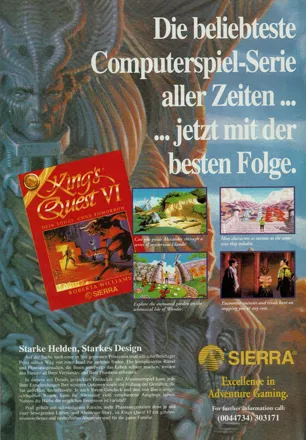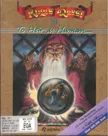King's Quest VI: Heir Today, Gone Tomorrow
Description official descriptions
For months Prince Alexander of Daventry has shut himself away from the world, thinking only of Princess Cassima, who he met while imprisoned in the previous game. Eventually he can take it no longer, and he hires a ship to search for the Land of the Green Isles located on the edge of the world. After months of searching he finally sets sight upon the island kingdom, only for a freak storm to strike the ship, destroying it and leaving him the only survivor. His troubles are far from over, however, as he soon finds out that the King and Queen have passed away, the Greens Isles are on the brink of war, and his beloved Princess Cassima may even be held prisoner by the royal vizier.
Like its predecessors in the series, King's Quest VI: Heir Today, Gone Tomorrow is a third-person puzzle-solving adventure game. For Alexander to save the Isles, he must travel between the Land's four magical islands, each based on myth and fables, and encounter people and strange beasts that will either help or hinder him. Alexander must be careful as well, because, as with all the King's Quest games, poor choices or missteps will often prove fatal for the Prince. Puzzles are solved linearly, although late in the game there are two completely different paths to take to reach the final confrontation. Like the previous game, actions are performed using a point-and-click interface with icons that represent verbs ("walk", "examine", "use", "talk", etc.).
The CD-ROM version of the game includes both DOS and Windows versions, full speech, a pre-rendered introduction, and the Girl in the Tower theme song.
Spellings
- 國王密使 VI:希望之旅 - Traditional Chinese spelling
Groups +
Screenshots
Promos
Credits (DOS version)
39 People (37 developers, 2 thanks) · View all
| Written & Designed by | |
| Produced by | |
| Directed by | |
| Art Designer | |
| Composer | |
| Text & Dialogue | |
| Senior Artist | |
| Team Artist | |
| Senior Programmer | |
| Sound | |
| Team Programmer | |
| Additional Music | |
| Quality Assurance | |
| Additional Sound Effects | |
| [ full credits ] | |
Reviews
Critics
Average score: 83% (based on 27 ratings)
Players
Average score: 4.0 out of 5 (based on 165 ratings with 11 reviews)
All right , but a step down from King's Quest 5.
The Good
Sierra (In my opinion) make the best adventure of the lot. Sierra finds a style , and sticks with it. Kings Quest 6 came with the familiar task bar , decent graphics , (mostly) bug free that you can usually expect from Sierra.
The only real good thing i can say about this game was that it was to the point and easy to understand. You didnt have to remember a great deal , just find the unusual items and try to work them together somehow.
In nutshell = Challenging - Interesting - Good to kill a few days with.
The Bad
Too childish , having stupid characters fresh out of alice in wonderland really doesnt do it for me.
Doesnt take itself seriously enough. To many in-game jokes making fun of both you (player) and the game. You cant get into the game properly when you have constant reminders that the game is considered a joke by the designers.
No King Graham! Who cares about his son? Although having Alexander rather than Rosella (kings quest 4) is more favourable.
After playing kings quest 5 , kings quest 6 is like a bad movie sequel, where none of the original actors want a part of it.
The Bottom Line
Barely memorable. Not worth more than ten bucks.
DOS · by Shayne Bates (12) · 2001
Classic adventure with a pretty facelift
The Good
King's Quest 6 plays as a classic fairy tale might. The plot is unusually complex and rich for the series, thanks to contributions by Gabriel Knight writer/designer Jane Jensen, who's design methods complemented Roberta Williams' perfectly in this installment.
The plot itself has been done before, even in the series (Prince Alexander sets out to rescue his love after seeing her trapped in a tower through an enchanted mirror), but the flair and atmosphere with which the game executed is phenomenal. Charmingly quirky at times and dark and mysterious at others, the game provides brain-teasing puzzles set against a vibrant environment that ranges in influence from Arabian Knights to Alice in Wonderland.
Beauty and the Beast's Robbie Benson does a solid job as the protagonist, and its ironically funny to hear him interact with the game's own equivalent of Beast. This was also the first entry in the series to offer multiple solutions to solve the game, one of which permitted you to skip a good 1/3rd of the game (this component was half-heartedly featured in the series' next installment as well).
The Windows version features newly-detailed character portraits that are a nice, if unnecessary, addition.
The Bad
Despite the multiple paths, the game's replayability factor is somewhat limited. Some of the puzzles are unnecessarily frustrating (this is during a time when Sierra cruelly worked anti-piracy techniques into the game's structure, frustrating those who owned legitimate copies), requiring you to save often and reattempt all-too-often. It's also very easy to miss something or make a mistake that will have fantastically bad and unforeseen consequences for the future. One such puzzle involves descending to the underworld to save the love interest's parents, only to discover that if when you get back, you forgot to pick up water from the River Styx, you are stuck without recourse and must load from a previous save. There are several instances like this where even people who have played the game multiple times before (myself included) can easily get stuck.
The Bottom Line
If you're an adventure gamer, you've already played this, and I don't have to say anything. If you're just getting into the series or the genre, this is an essential. A true classic.
Windows 16-bit · by jTrippy (58) · 2007
The Good
Finally, a King's Quest game that is less linear than the previous titles. There are multiple ways to solve some of the puzzles, and different paths and endings. It's also one of the last of the great breed of graphic adventures that allows the player to become stuck in dead ends and die in many different ways. In this respect, and because some of the puzzles are quite involved, the gameplay and difficulty are on par with most other challenging Sierra games of the day.
The graphics and sound are top-notch. At times I thought the otherwise beautiful hand painted artwork was too disjointed from location to location, though. I thought the art for the previous title -- King's Quest 5 -- was more suitable.
The opening scene was totally amazing in its day, especially on faster 386 or 486 PCs. Additionally, nicely integrated animations help bring out the artwork that serves as the backgrounds throughout the game. The sound is atmospheric, but sometimes a little too quiet, and carries one fatal flaw...the closing theme!
The Bad
GIRL IN THE TOWER. This has to be one of the most solid examples of a game company overextending that I can think of. (short of the FMV nightmare which came a little bit later). Although there are countless worse examples of music, "Girl In the Tower" was as excruciating for me to listen to then as it is for me to remember now, 8 or 9 years later. Go ahead and have a listen, I dare you.
"Girl in the tower, i'm reaching out, please tell me what to do....." Bad. Very bad indeed.
Aside from than that one song, there is not much that is wrong with KQ6. Unfortunately, it also doesn't stand out as being great. KQ6 is one of those games lost in history that few people, other than King's Quest and Roberta Williams fans, will likely want to go back and play. Put simply, there are many better graphic adventures.
The Bottom Line
King's Quest 6 carries this adventure series' storyline off on another tangent, this time as Alexander in the land of the Green Isles. The uninspired story is along the boring lines of 'rescue the princess' and helps put this game squarely on the "Good Games" pile instead of with the memorable classics.
DOS · by vni VIC (19) · 2001
Trivia
Amiga version
The back cover of the Amiga version contains information: "Beautiful graphics in 256 colours or 32 colours (two versions available)." but the game was released only in 32 colours version.
According to KQ VI reviews in Amiga Computing, Amiga Format and Amiga Power magazines Sierra originally planned to release a 256 colours version but decided that 32 colours version looked so good already so they shelved the idea.
The game was ported to the Amiga by Revolution Software, though the company wasn't credited on the box or in the manual. This is why this version uses Revolution's Virtual Theatre engine instead of SCI.
CD version
The CD version of King's Quest VI includes Girl in the Tower , the theme song to the game, composed by Mark Seibertm in full length. A sample of it can be heard on the floppy version for five seconds, then the game urges you to ring up radio stations that was listed in the manual and request it. Also the introduction was also extended in the CD version.
Music
Chris Braymen, the game's composer, quoted a Gregorian chant (Dies Irae) in the theme that plays when Prince Alexander is captured in the Catacombs of the Isle of the Sacred Mountain. It's a famous theme, quoted as well in many classical compositions such as Berlioz' Symphonie fantastique (5th part), in Stanley Kubrick's films The Shining and A Clockwork Orange, and also in Indiana Jones and the Fate of Atlantis (Room of the God Machine).
References
King's Quest VI's villain is named Abdul Alhazred; this name was taken from the work of horror and sci-fi writer H.P. Lovecraft. Abdul was a fictional character (also dubbed ''the Mad Arab'') who wrote the Necronomicon.
Technology
This was Sierra's first adventure game to feature their lipsyncing technology that they got when they bought out Bright Star Technology.
Awards
- Power Play
- Issue 02/1993 – #2 Best Presentation in 1992
Information also contributed by B14ck W01f, B.L. Stryker, game nostalgia and Jiguryo
Analytics
Upgrade to MobyPro to view research rankings and price history! (when applicable)
Related Sites +
-
Game Nostalgia
Provides extensive background info for King’s Quest VI: Heir Today, Gone Tomorrow, pictures of the cast and examples of voice-overs, full credits with shots and info about the design team, demo of the game, specific details about the game, various goodies, all musical themes, shots of every location in the game, video clips, saved games, a list of reviews, including a "nostalgic" review and tech specs. -
Hints for KQ6
These hints will help you solve the game.
Identifiers +
Contribute
Are you familiar with this game? Help document and preserve this entry in video game history! If your contribution is approved, you will earn points and be credited as a contributor.
Contributors to this Entry
Game added by Andy Roark.
Amiga added by POMAH. Windows 16-bit added by Mr. Huh. Macintosh added by Terok Nor.
Additional contributors: Adam Baratz, Katakis | カタキス, Jeanne, formercontrib, game nostalgia, Paulus18950, Patrick Bregger.
Game added May 23, 1999. Last modified December 16, 2024.
























